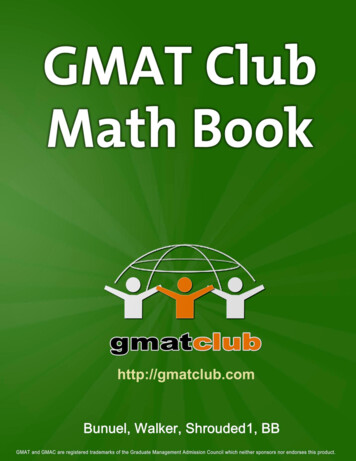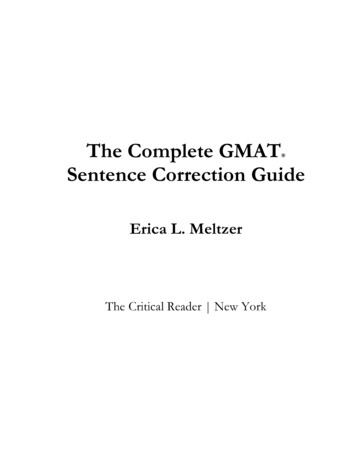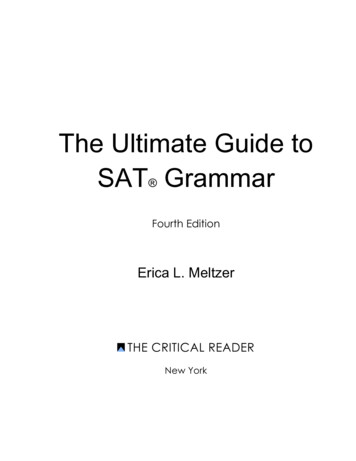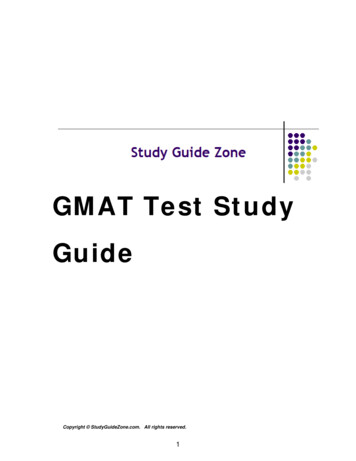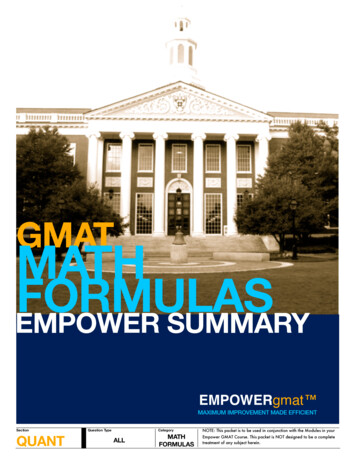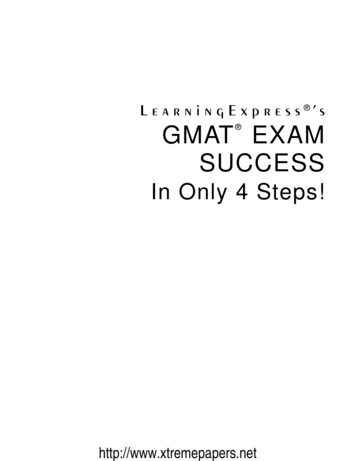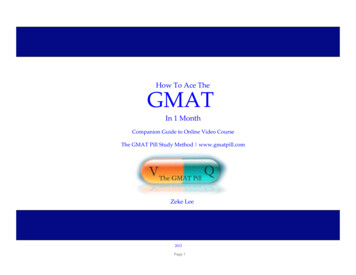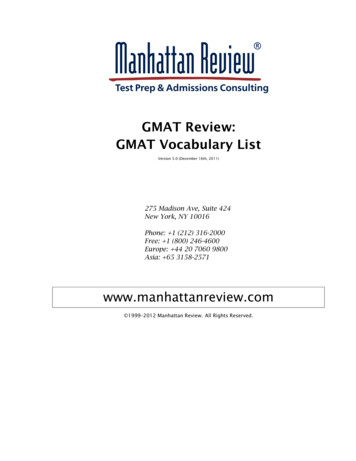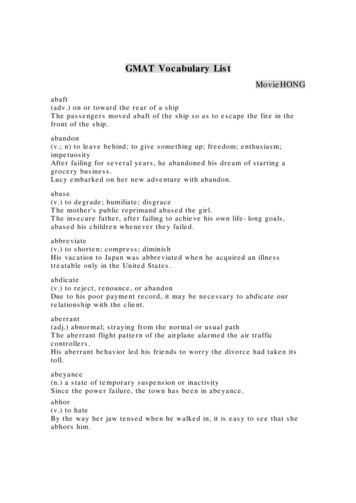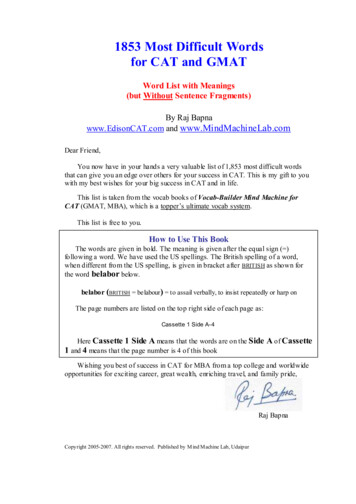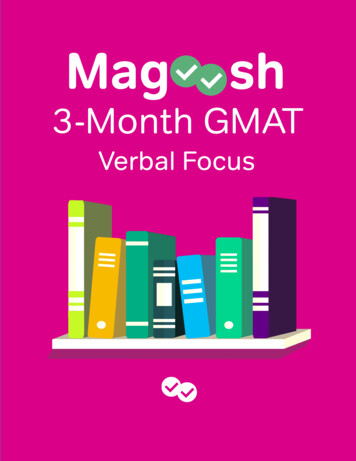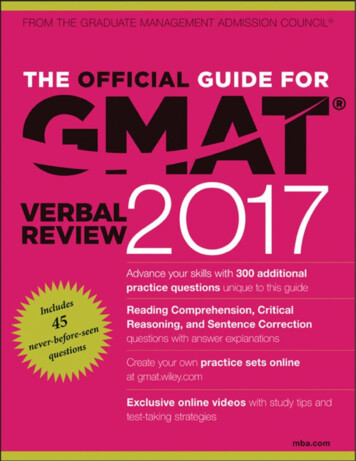
Transcription
THE OFFICIAL GUIDE FOR GMAT VERBAL REVIEW 2017Copyright 2016 by the Graduate Management Admission Council. All rights reserved.Published by John Wiley & Sons, Inc., Hoboken, New Jersey.No part of this publication may be reproduced, stored in a retrieval system or transmitted in any form orby any means, electronic, mechanical, photocopying, recording, scanning or otherwise, except aspermitted under Sections 107 or 108 of the 1976 United States Copyright Act, without either the priorwritten permission of the Publisher, or authorization through payment of the appropriate per-copy feeto the Copyright Clearance Center, 222 Rosewood Drive, Danvers, MA 01923, (978) 750-8400, fax (978)646-8600, or on the Web at www.copyright.com. Requests to the Publisher for permission should beaddressed to the Permissions Department, John Wiley & Sons, Inc., 111 River Street, Hoboken, NJ07030, (201) 748-6011, fax (201) 748-6008, or online at http://www.wiley.com/go/permissions.The publisher and the author make no representations or warranties with respect to the accuracy orcompleteness of the contents of this work and specifically disclaim all warranties, including withoutlimitation warranties of fitness for a particular purpose. No warranty may be created or extended bysales or promotional materials. The advice and strategies contained herein may not be suitable for everysituation. This work is sold with the understanding that the publisher is not engaged in rendering legal,accounting, or other professional services. If professional assistance is required, the services of acompetent professional person should be sought. Neither the publisher nor the author shall be liable fordamages arising here from. The fact that an organization or Web site is referred to in this work as acitation and/or a potential source of further information does not mean that the author or the publisherendorses the information the organization or Web site may provide or recommendations it may make.Further, readers should be aware that Internet Web sites listed in this work may have changed ordisappeared between when this work was written and when it is read.Trademarks: Wiley, the Wiley Publishing logo, and related trademarks are trademarks or registeredtrademarks of John Wiley & Sons, Inc. and/or its affiliates. The GMAC and GMAT logos, GMAC ,GMASS , GMAT , GMAT CAT , Graduate Management Admission Council , and GraduateManagement Admission Test are registered trademarks of the Graduate Management AdmissionCouncil (GMAC ) in the United States and other countries. All other trademarks are the property oftheir respective owners. Wiley Publishing, Inc. is not associated with any product or vendor mentionedin this book.For general information on our other products and services or to obtain technical support please contactour Customer Care Department within the U.S. at (877) 762-2974, outside the U.S. at (317) 572-3993 orfax (317) 572-4002.Wiley also publishes its books in a variety of electronic formats. Some content that appears in print maynot be available in electronic books. For more information about Wiley products, please visit our Website at www.wiley.com.ISBN 978-1-119-25395-2 (pbk); ISBN 978-1-119-25396-9 (ePDF); ISBN 978-1-119-25398-3 (ePUB)Updates to this book are available on the Downloads tab at this site:http://www.wiley.com/go/gmat2017updates.
Contents1.0 What Is the GMAT Exam?1.0 What Is the GMAT Exam?1.1 Why Take the GMAT Exam?1.2 GMAT Exam Format1.3 What Is the Content of the Exam Like?1.4 Quantitative Section1.5 Verbal Section1.6 What Computer Skills Will I Need?1.7 What Are the Test Centers Like?1.8 How Are Scores Calculated?1.9 Analytical Writing Assessment Scores1.10 Test Development Process2.0 How to Prepare2.0 How to Prepare2.1 How Can I Best Prepare to Take the Test?2.2 What About Practice Tests?2.3 Where Can I Get Additional Practice?2.4 General Test-Taking Suggestions3.0 Reading Comprehension3.0 Reading Comprehension3.1 What Is Measured3.2 Test-Taking Strategies3.3 The Directions3.4 Sample Questions3.5 Answer Key3.6 Answer Explanations4.0 Critical Reasoning4.0 Critical Reasoning4.1 What Is Measured4.2 Test-Taking Strategies
4.3 The Directions4.4 Sample Questions4.5 Answer Key4.6 Answer Explanations5.0 Sentence Correction5.0 Sentence Correction5.1 Basic English Grammar Rules5.2 Study Suggestions5.3 What Is Measured5.4 Test-Taking Strategies5.5 The Directions5.6 Sample Questions5.7 Answer Key5.8 Answer ExplanationsAppendix A Answer SheetsReading Comprehension Answer SheetCritical Reasoning Answer SheetSentence Correction Answer SheetAdvertOnline Question Bank InformationEULA
Visit gmat.wiley.com to access web-based supplemental featuresavailable in the print book as well. There you can access a question bankwith customizable practice sets and answer explanations using 300Reading Comprehension, Critical Reasoning, and Sentence Correctionquestions. Watch exclusive videos highlighting the skills necessary toperform well on the Verbal section of the exam and addressing concernsof non-native English speakers.
1.0 What Is the GMAT Exam?
1.0 What Is the GMAT Exam?The Graduate Management Admission Test (GMAT ) is a standardized,three-part test delivered in English. The test was designed to help admissionsofficers evaluate how suitable individual applicants are for their graduatebusiness and management programs. It measures basic verbal, mathematical,and analytical writing skills that a test-taker has developed over a long periodof time through education and work.The GMAT exam does not measure a person’s knowledge of specific fields ofstudy. Graduate business and management programs enroll people frommany different undergraduate and work backgrounds, so rather than testyour mastery of any particular subject area, the GMAT exam will assess youracquired skills. Your GMAT score will give admissions officers a statisticallyreliable measure of how well you are likely to perform academically in thecore curriculum of a graduate business program.Of course, there are many other qualifications that can help people succeedin business school and in their careers—for instance, job experience,leadership ability, motivation, and interpersonal skills. The GMAT exam doesnot gauge these qualities. That is why your GMAT score is intended to beused as one standard admissions criterion among other, more subjective,criteria, such as admissions essays and interviews.
1.1 Why Take the GMAT Exam?GMAT scores are used by admissions officers in over 6,000 graduatebusiness and management programs worldwide. Schools that requireprospective students to submit GMAT scores in the application process aregenerally interested in admitting the best-qualified applicants for theirprograms, which means that you may find a more beneficial learningenvironment at schools that require GMAT scores as part of your application.Because the GMAT exam gauges skills that are important to successful studyof business and management at the graduate level, your scores will give you agood indication of how prepared you are to succeed academically in agraduate management program; how well you do on the test may also helpyou choose the business schools to which you apply. Furthermore, thepercentile table you receive with your scores will tell you how yourperformance on the test compares to the performance of other test takers,giving you one way to gauge your competition for admission to businessschool.Myth -vs- FACTM – If I don’t score in the 90th percentile, I won’t get into any schoolI choose.F – Very few people get very high scores.Fewer than 50 of the more than 200,000 people taking the GMAT exameach year get a perfect score of 800. Thus, while you may beexceptionally capable, the odds are against your achieving a perfect score.Also, the GMAT exam is just one piece of your application packet.Admissions officers use GMAT scores in conjunction with undergraduaterecords, application essays, interviews, letters of recommendation, andother information when deciding whom to accept into their programs.Schools consider many different aspects of an application before making anadmissions decision, so even if you score well on the GMAT exam, youshould contact the schools that interest you to learn more about them and toask about how they use GMAT scores and other admissions criteria (such asyour undergraduate grades, essays, and letters of recommendation) toevaluate candidates for admission. School admissions offices, web sites, andmaterials published by schools are the key sources of information when you
are doing research about where you might want to go to business school.For more information on the GMAT, test preparation materials, examregistration, how to use and send your GMAT scores to schools, and applyingto business school, visit mba.com.
1.2 GMAT Exam FormatThe GMAT exam consists of four separately timed sections (see the table onthe next page). The test starts with one Analytical Writing Assessment(AWA) essay prompt, and you will have 30 minutes to type your essay on acomputer keyboard. The AWA is followed immediately by the 30-minuteIntegrated Reasoning section, which features 12 question prompts in fourdifferent question formats. The test ends with two 75-minute, multiplechoice sections: the Quantitative section, with 37 questions, and the Verbalsection, with 41.The GMAT is a computer-adaptive test (CAT), which means that in themultiple-choice sections of the test, the computer constantly gauges how wellyou are doing on the test and presents you with questions that areappropriate to your ability level. These questions are drawn from a huge poolof possible test questions. So, although we talk about the GMAT as one test,the GMAT exam you take may be completely different from the test of theperson sitting next to you.Here’s how it works. At the start of each GMAT multiple-choice section(Verbal and Quantitative), you will be presented with a question of moderatedifficulty. The computer uses your response to that first question todetermine which question to present next. If you respond correctly, the testusually will give you questions of increasing difficulty. If you respondincorrectly, the next question you see usually will be easier than the one youanswered incorrectly. As you continue to respond to the questions presented,the computer will narrow your score to the number that best characterizesyour ability. When you complete each section, the computer will have anaccurate assessment of your ability.
Myth -vs- FACTM – Getting an easier question means I answered the last one wrong.F – Getting an easier question does not necessarily mean you got theprevious question wrong.To ensure that everyone receives the same content, the test selects aspecific number of questions of each type. The test may call for your nextquestion to be a relatively hard problem-solving item involvingarithmetic operations. But, if there are no more relatively difficultproblem-solving items involving arithmetic, you might be given an easieritem.Most people are not skilled at estimating item difficulty, so don’t worrywhen taking the test or waste valuable time trying to determine thedifficulty of the questions you are answering.Because each question is presented on the basis of your answers to allprevious questions, you must answer each question as it appears. You maynot skip, return to, or change your responses to previous questions. Randomguessing can significantly lower your scores. If you do not know the answerto a question, you should try to eliminate as many choices as possible, thenselect the answer you think is best. If you answer a question incorrectly bymistake—or correctly by lucky guess—your answers to subsequent questionswill lead you back to questions that are at the appropriate level of difficultyfor you.Each multiple-choice question used in the GMAT exam has been thoroughlyreviewed by professional test developers. New multiple-choice questions aretested each time the test is administered. Answers to trial questions are notcounted in the scoring of your test, but the trial questions are not identifiedand could appear anywhere in the test. Therefore, you should try to do yourbest on every question.The test includes the types of questions found in this guide, but the formatand presentation of the questions are different on the computer. When youtake the test:Only one question at a time is presented on the computer screen.The answer choices for the multiple-choice questions will be preceded bycircles, rather than by letters.
Different question types appear in random order in the multiple-choicesections of the test.You must select your answer using the computer.You must choose an answer and confirm your choice before moving on tothe next question.You may not go back to change answers to previous questions.Format of the GMAT ExamQuestions TimingAnalytical Writing130 min.1230 min.3775 min.4175 min.Analysis of an ArgumentIntegrated ReasoningMulti-Source ReasoningTable AnalysisGraphics InterpretationTwo-Part AnalysisOptional breakQuantitativeProblem SolvingData SufficiencyOptional breakVerbalReading ComprehensionCritical ReasoningSentence CorrectionTotal Time: 210 min.
1.3 What Is the Content of the Exam Like?It is important to recognize that the GMAT exam evaluates skills and abilitiesdeveloped over a relatively long period of time. Although the sections containquestions that are basically verbal and mathematical, the complete testprovides one method of measuring overall ability.Keep in mind that although the questions in this guide are arranged byquestion type and ordered from easy to difficult, the test is organizeddifferently. When you take the test, you may see different types of questionsin any order.
1.4 Quantitative SectionThe GMAT Quantitative section measures your ability to reasonquantitatively, solve quantitative problems, and interpret graphic dat
The GMAT exam consists of four separately timed sections (see the table on the next page). The test starts with one Analytical Writing Assessment (AWA) essay prompt, and you will have 30 minutes to type your essay on a computer keyboard. The AWA is followed immediately by the 30-minute Integrated Reasoning section, which features 12 question prompts in four different question formats. The test .
